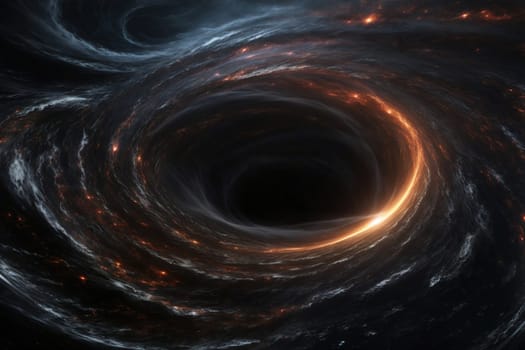According to researchers, the universe could be way older than we thought—26.7 billion years old—and dark matter may not even be a thing.
The new theory is convincing, as it is consistent with the latest observations ranging from the rotation speed of the Milky Way to the cosmic microwave background radiation in the distant universe.
The researchers believe their study proves the universe is 26.7 billion years old, and it doesn’t need dark matter to exist.
There have been many papers in the past that have raised doubts about the existence of dark matter, but this is the first paper to rule out dark matter while still being consistent with actual observational results.
Dark matter was born as a safeguard to protect theories from observational results.
Dark matter is described as an “invisible substance” because it doesn’t engage with normal matter, light, or other forces like electricity or magnetism, and only interacts via gravity.
For example, even if dark matter is placed at the same coordinates as normal water molecules, they can coexist without pushing against each other because they do not interact with each other.
Also, since it does not interact with light or electromagnetic forces and is only influenced by gravity, a gravity detection device is required to measure it directly.
The concept of “invisible matter” popped up after scientists measured how fast stars in the galaxy were rotating and realized the numbers didn’t add up.
The stars in our galaxy follow a pattern like the planets in our solar system, moving quickly near the center and gradually slowing down as they reach the edges.
However, detailed measurements of the orbital speed of stars revealed that the orbital speed of stars in the outer galaxy is much faster than predicted by theory.
It was also discovered that gravitational lensing, which utilizes the bending of space caused by celestial bodies, is more powerful than theoretically predicted.
Dark matter has come to be used as a means to fill the gap between these theories and observational results.
By adding the existence of unobservable dark matter, existing theories worked very smoothly.
In a way, dark matter has been like a safety net, keeping our understanding of the universe from being thrown off by surprising observations.
Now if we can just confirm the existence of dark matter, then everything will be ok.
No matter how hard we try, detecting dark matter continues to be impossible.
Despite trying every method imaginable, no trace was found.
Further challenges to existing cosmology continued.
According to recent findings from the James Webb Space Telescope, there are galaxies out there that shouldn’t exist, based on our current understanding of the universe.
Existing cosmology holds that it takes billions of years for galaxies to develop the structures and shapes we see.
The discovery of billion-year-old galaxies in a billion-year-old universe makes the excuses even more difficult.
(Similarly, galaxies that should not exist in existing cosmology are being discovered one after another.)
Therefore, in recent years, there have been gradually increasing attempts to abandon dark matter as a protective force for the existing cosmology and to seek a new cosmology that does not rely on dark matter.
A new study from January 8, 2024, showed that observing binary stars at great distances could mean we might have to rethink some of the core ideas about gravity from Newton and Einstein. The study offers a different approach called “modified Newtonian dynamics (MOND),” which could explain the behavior of binary stars without using dark matter.
(*MOND has shown that the minute gravity acting over long distances is higher than the theoretical value.) Meanwhile, a new theory proposed by researchers at the University of Ottawa approaches the issue from a completely different angle.
Existing theories assume that the strength of natural forces involved in particle interactions, such as gravity, known as “coupling constants,” does not change over time.
It is also believed that the intensity of the light does not change over time, and no energy is lost, no matter how long the distance it travels.
However, new theories include the concept that the strength of this natural force, the “coupling constant,” weakens over time (CCC theory) and According to this concept, light fades and loses energy over long journeys (TL theory), which is integrated with the CCC theory.
Either of these theories has problems when used alone, but the new “CCC+TL theory,” as its name suggests, combines the two.
Once the theory was complete, the researchers first examined whether the rotation speeds of the galaxy’s center and outer edge matched the theoretical values.
Existing cosmology cannot derive the correct rotation speed without relying on dark matter.
However, when the “CCC + TL” theory is applied, it is found that the observed rotation speed of the center and outer edge matches that of the galaxy even in the absence of dark matter. The researchers then performed a verification test using observations of special oscillation patterns seen in the cosmic microwave background radiation (baryon acoustic oscillations, or BAOs).
The darker areas of the cosmic microwave background radiation become the cores of galaxies, making it possible to predict the distribution of visible matter throughout the universe.
The “CCC+TL theory” turns out to be consistent with certain characteristics of background radiation.
These results show that the CCC+TL theory is consistent with observed values over a wide range, including the rotation speed of stars around the galaxy and the cosmic microwave background radiation.
Although many theoretical studies have been conducted to date that deny the existence of dark matter, this is the first time that a theory that eliminates dark matter has actually matched actual observational results.
Furthermore, if the “CCC + TL theory” holds true, the age of the universe is 26.7 billion years, which also solves the problem of the age of “galaxies that should not exist.” Furthermore, if the CCC+TL theory is correct, the mechanism behind the accelerated expansion of the universe will also change.
The CCC+TL theory does not deny the accelerating expansion of the universe, but states that this is due to the weakening of “natural forces” in tandem with the expansion of the universe.
The natural forces referred to here are the four most basic forces: gravity, the strong force, the weak force, and electromagnetic force.
The CCC+TL theory is a fairly promising theory that matches observational results without the presence of dark matter.
However, not all astrophysicists agree with the new theory.
It is true that existing cosmological theories that rely on dark matter have some problems, such as the observation of galaxies that should not exist and the inability to predict the movements of distant binary stars, but other than that they have generally worked well.
So, if you make a public statement about the age of the universe, it’s probably best to say “13.7 billion years” for now.

